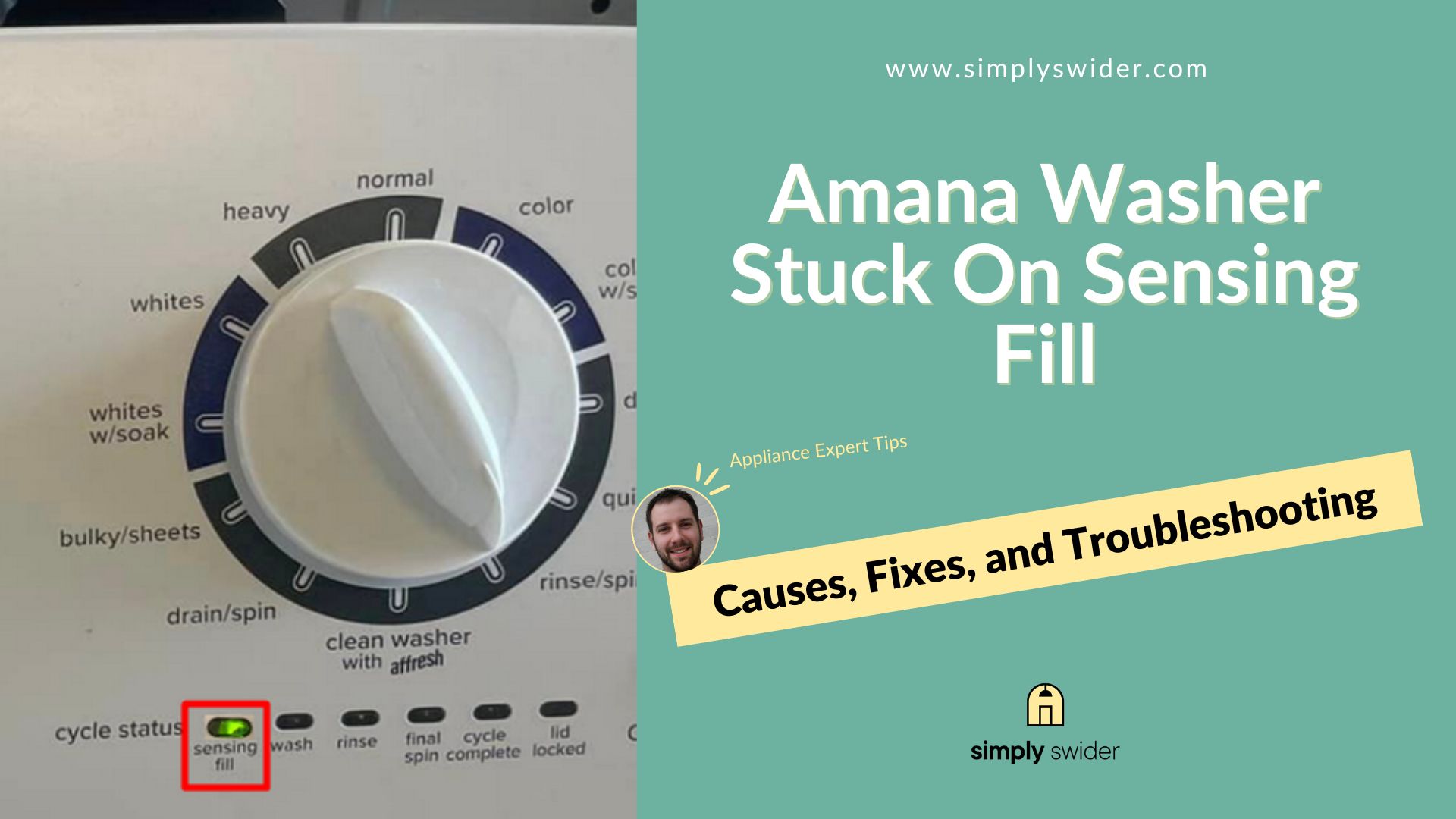By design:
Amana washers take around 3 minutes during the sensing fill stage. Here, the washer will balance and weigh the load to determine the amount of water to add.
But here’s the deal:
If it’s lingering on this stage for longer and refusing to proceed to wash, it means we’ve got a problem.
Now:
Forget what you’ve heard—being stuck on ‘sensing fill’ doesn’t mean your Amana washer is down for the count.
It’s a common problem, and some of the causes are actually quite simple to fix.
In this post, I will discuss the causes, troubleshooting steps, and how to fix this problem.
Let’s get into it.

Table of Contents
Why Is My Amana Washing Machine Stuck On Sensing Fill?
When your Amana washer is stuck on sensing fill, there are a few possible culprits at play. First, it might not be getting enough water, which could be due to a blocked water inlet valve, a kinked hose, or low water pressure. There could also be a faulty component. Either the shift actuator, drive motor, control board, water inlet valves, or drive belt.
Don’t worry, though—we’ll explore each of these potential causes and the appropriate fix to get your Amana washer back on track in no time.
To bring you the most comprehensive troubleshooting guide, I teamed up with none other than the amazing Ronnie Lyman.
What Does Sensing Fill Mean On An Amana Washer?
But before we dive into the nitty-gritty, let’s take a moment to understand what we’re dealing with here.
As Ronnie explains, “The sensing fill is like a weightlifting session to determine the load weight and the amount of water to add.”
How does this happen?
Well, the washer begins by locking the lid. It then moves the drum or tub to allow the sensors and other components to do their jobs.
- Parts involved: Control Board, Lid Lock, Sensors, Shift Actuator, Capacitor, Motor, And Drive Belt.
After determining the weight of the load, the control board steps in to determine the amount of water needed.
It then sends a signal to the water inlet valve to allow water to flow into the washer.
- Parts involved: Water inlet valve, Water supply hoses, and Control board
The control board then awaits a signal from the water level pressure switch to confirm when the water reaches the desired level.
As per Ronnie’s expertise, “If one of these parts experiences a malfunction or is faulty, the entire process cannot proceed.”
Let’s go a step further and discuss each of these causes.
| Specific Causes | |
| Water supply problem | Clogged water inlet screen The water supply hoses are off Kinked or clogged hoses Low water pressure |
| Faulty component | Shift actuator Water inlet valve Drive belt Motor Water level pressure switch Control board |
| Others | The washer is stuck because of a software glitch Sensors need recalibration The lid isn’t locked The washer is overloaded |
9. Causes, Fixes, and Troubleshooting Tips for Amana Washer Stuck on Sensing Fill
| Commonly Affected Parts | Part Replacement Cost |
|---|---|
| Actuator Switch | $20-$100 |
| Water inlet valve | $50-$100 |
| Lid switch | $30-$100 |
| Water level pressure switch | $30-$150 |
| Motor | $100-$450 |
| Capacitor | $50-$100 |
| Motor coupling | $20-$50 |
| Control board | $200-$600 |
| Drive belt | $20-$70 |
1. The Washer is Stuck
I asked Ronnie: “When you are called to fix an Amana washer that is stuck on sensing, where do you start?”
His answer…
“I start with inspecting two of the easiest-to-fix causes; water supply problems and software glitches.”
Problem:
Just like any electronic appliance, your trusty Amana washer is susceptible to software glitches.
Identification:
According to Ronnie, “The most effective way to troubleshoot and fix a software glitch or bug is to reset the washer.”
Solution:
First, unplug the washer from the power outlet or flip the circuit breaker off.
Then let the washer sit unplugged for up to 5 minutes or longer, as this user did with her Amana NTW4516FW High Efficiency, and plug it back in.
Ronnie also recommends alternative reset methods, such as:
- Opening and closing the lid 6 times in 12 seconds.
- Recalibrating the washer using the cycle selector dial.
- Using the Start/Cancel button
2. The Washer Requires Recalibration
Problem:
Now:
During the sensing phase, some of the key components at play are the sensors.
According to Ronnie, “If any of the sensors is malfunctioning, it can cause the washer to get stuck in the phase.”
For instance:
If the water level sensor is miscalibrated, it can relay inaccurate water levels, which can lead to flow of water being halted prematurely
Consequently, the washer will remain in “sensing fill” mode as it waits for the correct water level to be reached.
Identification:
Bad news:
Identifying a miscalibrated sensor can be as challenging as finding a needle in a haystack.
Luckily:
Recalibrating the washer can often resolve the issue if a miscalibrated sensor is the culprit.
Solution:
To recalibrate an Amana washer, you will use the same process that you use when recalibrating Maytag and Whirlpool washers.
Hey, and did you know that Whirlpool owns KitchenAid, Maytag, and Amana brands? That’s why they have common features.
How to recalibrate an Amana washing machine:
- Step 1: Unplug the washer from the power outlet. Let it sit unplugged for a good 3 minutes and then plug it back in.
- Step 2: Rotate the cycle selector knob counterclockwise several times and set it back to normal.
- Step 3:
Now, to the most important part.
In 3-6 seconds, rotate the selector knob, in the following sequence.
- Clockwise (right) 1 click and wait ½ second.
- Clockwise (right) 1 click and wait ½ second.
- Clockwise (right) 1 click and wait ½ second.
- Counter-Clockwise (left) 1 click and wait ½ second.
- Clockwise (right) 1 click.
If you entered the diagnostic mode, all the LED lights should start blinking. If they aren’t, repeat the process. Also, consult your washer’s tech sheet.
- Step 4: Rotate the dial clockwise until only the rinse LED is on. Then press the start button. The washer will start the recalibration process.
- Step 5: Run a quick test cycle to determine if the issue has been resolved.
3. Water Flow Issue
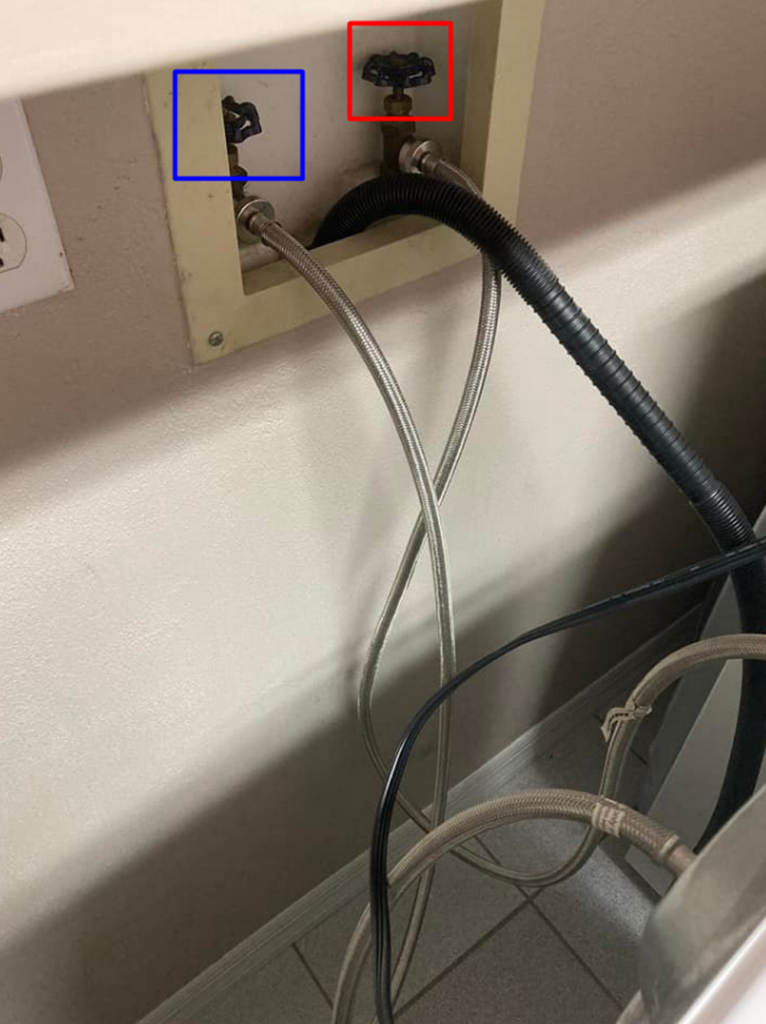
From our Facebook appliance repair group, a significant number of issues with Amana washers getting stuck on the sensing fill cycle can be traced back to water supply issues.
Now:
As Ronnie rightly put it, “By design, your Amana washer cannot start a wash cycle if it hasn’t been filled with enough water.”
Water supply issues are primarily caused by:
- Blocked inlet screens
- Water valves not being fully open
- Low water pressure
Identification:
The first components you should inspect are hot and cold water valves. I’ve encountered cases where one or both valves were only partially open.
Next up:
How is the water pressure? Here, open one of the faucets and assess if the pressure looks normal.
Finally:
Lastly, locate and inspect the inlet screens.
Check if the inlet screens are clogged or blocked, as this would significantly reduce the flow of water.
For instance, this user on Reddit found that the cause of the problem with his Amana NTW4516FW1 washer was the cold water supply.
Solution:
“If the inlet screens are clogged or blocked, rinse them under running water. Use a soft brush to remove stubborn sediments and dirt,” Ronnie explains.
3. Faulty Shift Actuator

| Part | Actuator Switch |
| Location | At the bottom of the washer |
| Ease of troubleshooting | Medium |
| Replacement part cost | $20-$100 |
| Repairable | No |
Another question I asked Ronnie was his pick for the most notorious cause of Amana washers getting stuck on sensing fill.
“It’s the shift actuator. This sneaky culprit often goes unnoticed by many, even though it’s relatively simple to troubleshoot and fix,” he said.
Problem:
During the sense fill, you might notice a couple of slow spins as the washer senses the load weight and distributes it.
This is where the shift actuator comes into play.
According to Ronnie, “It’s responsible for shifting the transmission between different cycles.”
During sensing fill, the washer engages the shift actuator to activate the rotation of the agitator or impeller.
Now:
If the shift actuator is faulty, the washer won’t proceed to the wash cycle.
Identification:
Start by locating the shift actuator. Typically, you will find it at the bottom of the machine.
Next:
Inspect it for signs of cracks, breakage, or normal wear. Also, examine the wires and harness connected to it. Finally, use a multimeter to test if it’s working correctly.
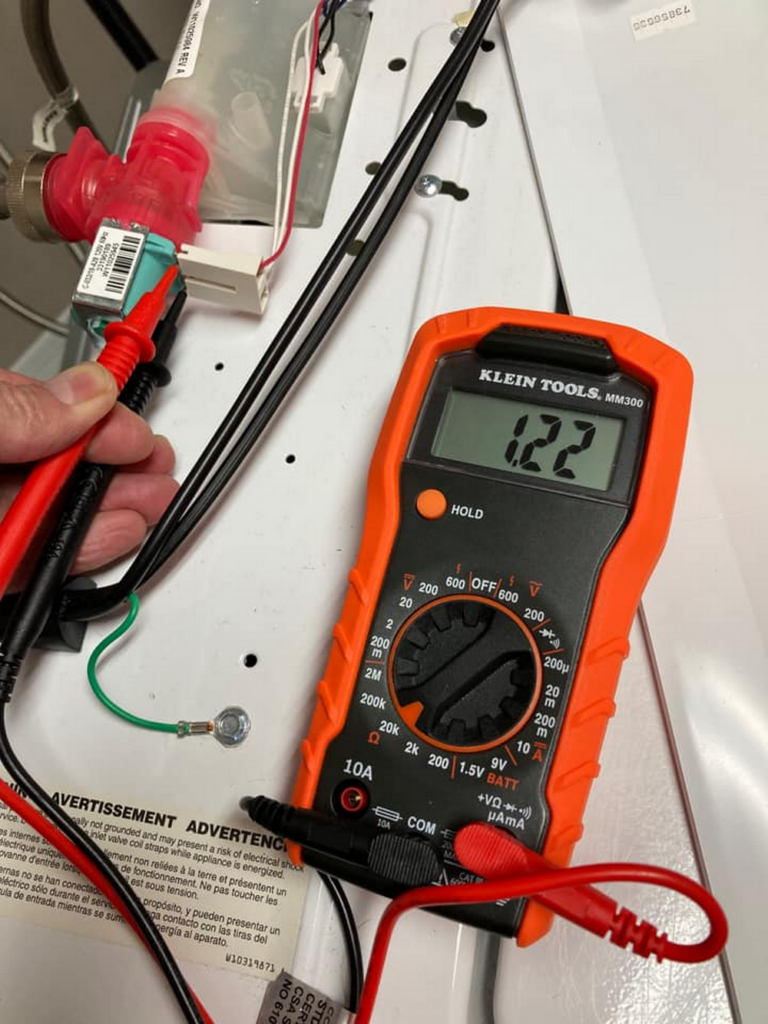
Solution:
If the shift actuator is faulty or damaged, replace it with a new one.
4. Faulty Water Inlet Valve
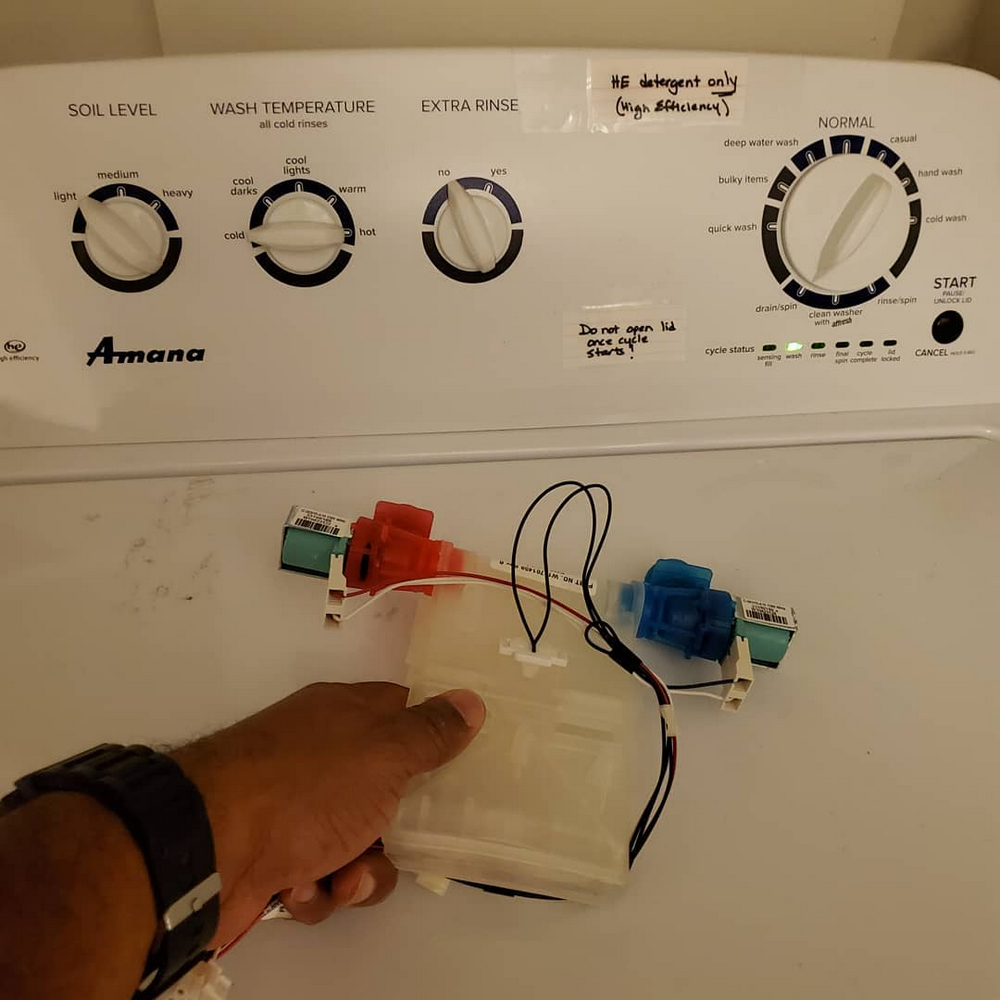
| Part | Water inlet valve |
| Location | Connected to the water supply hoses |
| Ease of troubleshooting | Hard |
| Replacement part cost | $50-$150 |
| Repairable | No |
Problem:
Unlike more visible causes like blocked inlet screens, a faulty water inlet valve, hidden within the unit, can be a stealthy cause of an Amana washer getting stuck on the sensing fill.
Now:
Once the washer has determined the appropriate amount of water to add, the main control board swings into action.
“It sends signals to the solenoids to open the inlet valves. For this to happen, the solenoids must be energized, creating a magnetic field that pulls the valves open,” Ronnie explains.
However:
Sometimes, one or both of the water inlet valves fail to open properly.

Identification:
First things first, locate the inlet valves. They are usually located at the point where the water supply hoses connect to the washer.
Next:
Examine the valves for cracks, leaks, or blockages. Take a close look at the electrical connections and solenoids.
Finally:
“With the washer unplugged and the water hoses disconnected, use a multimeter to test for continuity across the terminals of the solenoids,” Ronnie adds.
Solution:
Water inlet valves are not designed to be repaired. If they’re indeed the cause, replace them
5. Lid Is Not Locked
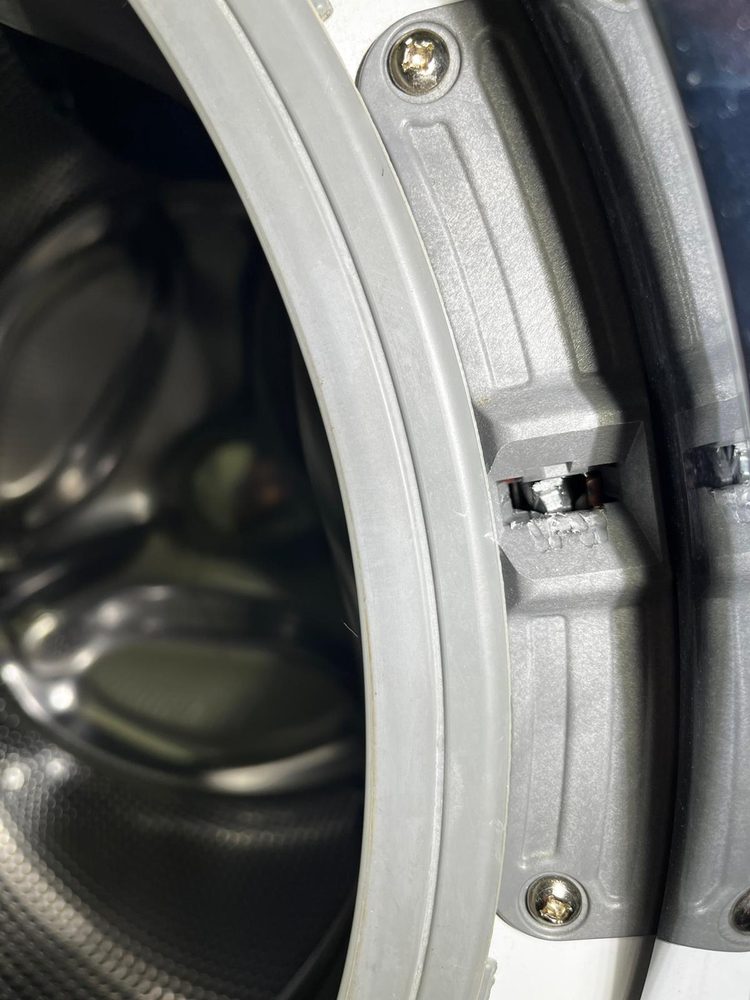
| Part | Lid switch |
| Location | Underneath the lid |
| Ease of troubleshooting | Medium |
| Replacement part cost | $20-$100 |
| Repairable | No |
Problem:
Have you ever noticed that when you load and start a wash cycle, your Amana washer locks the lid, and you hear that clicking sound?
Now:
If, for some reason, the washer isn’t able to lock the lid, it cannot complete the sense fill phase.
For instance:
This user found that the reason his Amana NTW4516FW1 wasn’t proceeding past sense fill was simply because the lid wasn’t fully engaged.
There are several reasons why this could happen:
- Faulty lid lock switch
- The lid isn’t fully engaged
- Obstruction
- The lid is not properly aligned
- Loose or damaged wires between the lid switch and control board
Identification:
First, take a look for any obstructions, like debris or clothing, that might be preventing the lid from closing properly.
Next:
Close the lid and inspect if it’s engaging securely. The next culprit to troubleshoot is the lid switch.
As Ronnie explains,
“The lid switch is the component that detects and reports to the control board whether the lid is open or locked.”
When the lid is locked, the lid switch signals to the control board that it is safe to proceed.
To troubleshoot it, locate it underneath the lid. Once you have this bad boy, inspect it for any loose wires or broken parts.
Finally, use a multimeter to test its continuity across the terminals or bypass it.
Solution:
Unless you find damaged wires that can be repaired, it’s recommended to replace the lid switch if it’s the culprit.
6. Faulty Water Level Pressure Switch

| Part | Water level switch |
| Location | Towards the rear of the washer, near the control panel. |
| Ease of troubleshooting | Hard |
| Replacement part cost | $30-$150 |
| Repairable | No |
Problem:
The water level switch, an unassuming yet vital component in your Amana washer, can be the hidden culprit behind it getting stuck on the sensing fill.
This little device and the hose keep a watchful eye on the water level inside the tub.
“When the tub has enough water, it signals the control board, which in turn signals the water inlet valve to stop filling the tub,” Ronnie elaborates.
However, the pressure switch can malfunction.
For instance:
If it’s faulty, it could falsely signal the control board that the tub has enough water.
Result?
The inlet valves prematurely halt the flow of water, leaving the washer without sufficient water.
Identification:
The first sign that the pressure switch may be at fault is if there is very little or no water flowing in, yet the water valves are fully open.
Next:
It’s time to inspect the pressure switch. You will find it near the control panel and connected by a pressure hose to the side of the tub.
Begin by checking the hose to ensure it’s not kinked, blocked, or disconnected. Then disconnect it from the switch and blow into it.
Finally, test it using a multitester to determine if it’s functioning properly.
Solution:
“If you find that the water level pressure switch is indeed defective, the most effective remedy is to replace it,” Ronnie advises.
7. A Problem With The Drive Motor, Capacitor, or Motor Coupling
| Part | Drive motor Capacitor Motor coupling |
| Location | Below the washer |
| Ease of troubleshooting | Easy to Medium |
| Replacement part cost | Drive motor – $100-$450 Capacitor – $50-$100 Motor coupling -$20-$50 |
| Repairable | Drive motor – Yes Capacitor – No Motor coupling – No |
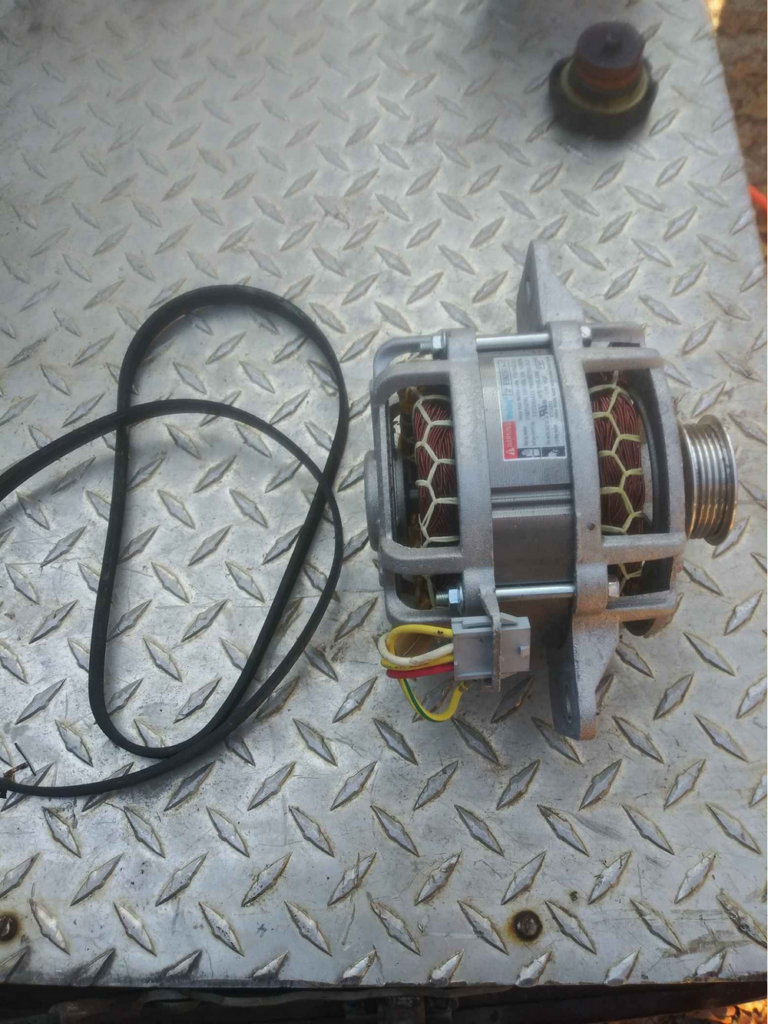
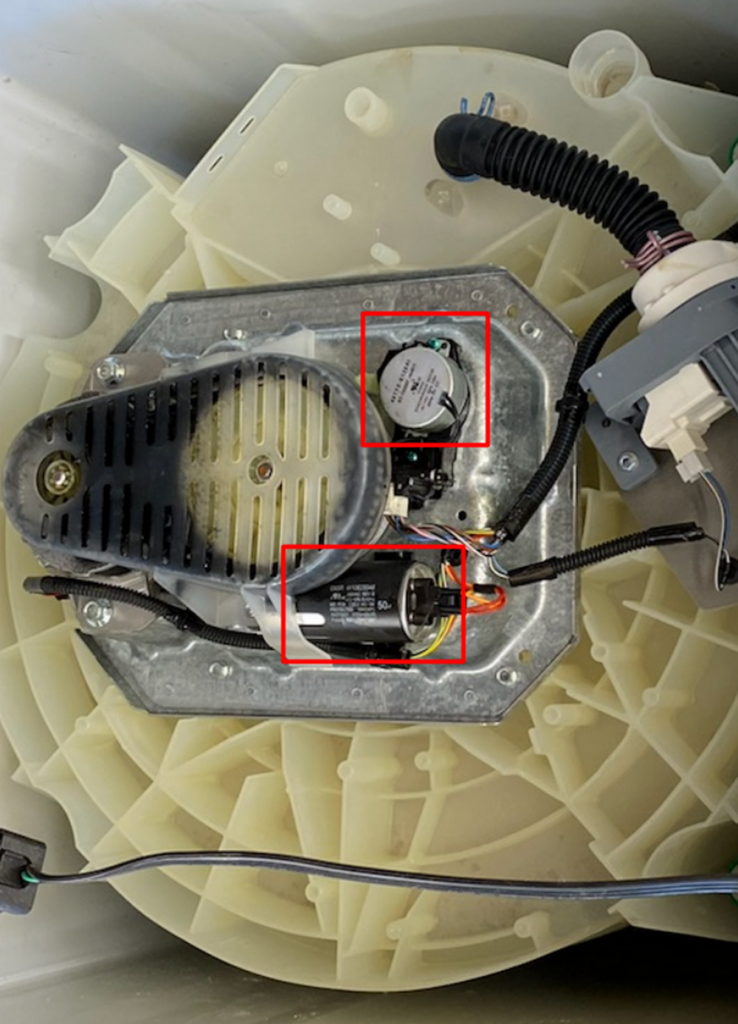
Problem:
Let’s discuss another potential cause involving the drive motor, capacitor, or motor coupling.
Although these are three separate components, they are closely related and can impact one another.
Here’s what you need to know:
As Ronnie explains,
“During the sensing fill phase, the washer performs small spins to determine the load weight. This is where these three components are involved.”
First, we have the drive motor, which is responsible for moving the drum and agitator. If it’s faulty, it won’t provide the necessary spins required during load sensing.
On the other hand, the capacitor provides the motor with the initial power boost needed during startup.
If it’s faulty, the motor won’t power, and hence the drum won’t spin.
Last but not least, we have the motor coupling, which connects the motor to the transmission or agitator.
Since it’s made of plastic, it’s susceptible to breakage and wear over time.
If the motor coupler is damaged, the motor won’t be able to move the drum or impeller, which is crucial during the sensing fill phase.
Identification:
To locate these parts, carefully tip over the washer for better access.
“First, you’ll spot the capacitor. Unscrew it and inspect it for any bulging, leaking, or burnt smell. Secondly, use a multitester with a capacitance mode to test if the capacitor is working correctly,” Ronnie says.
Next:
Next, inspect the motor and test it for continuity to ensure its proper functioning.
Finally,
Locate the motor coupler between the motor and the transmission. Since it’s made of plastic, it’s easy to spot any visible damage or wear.
Solution:
If you find that the capacitor or motor coupler is damaged, replace them
When it comes to the motor, the fix will depend on the specific cause of the issue.
Fortunately, motor damage is quite rare. In most cases, issues like damaged wiring or faulty error codes are repairable.
8. Damaged Drive Belt

| Part | Drive belt |
| Location | Below the washer |
| Ease of troubleshooting | Easy |
| Replacement part cost | $20-$70 |
| Repairable | No |
Problem:
Another possible cause for an Amana washer getting stuck on sense fill is damaged drive belts.
According to Ronnie,
“Some Amana washers utilize a sequence of gentle spins to ascertain the load’s weight, and that’s where the drive belt plays its part.”
If the drive belt is worn out, slipping, or broken, it can hinder the proper spinning of the drum.
Identification:
Troubleshooting the drive belt is relatively straightforward.
“Begin by locating it below the washer and carefully inspect it for any signs of fraying, cracks, or slack,” Ronnie advises.
Pay attention to both sides and examine the entire length of the belt.
Lastly, check the tension and alignment of the drive belt. It should feel firm but not overly tight.
Solution:
If you notice any significant wear or damage during the inspection, replace the drive belt. The good news is that drive belts are generally affordable and relatively easy to replace.
Conclusion
A crucial phase in the operation of an Amana washing machine is the sense-fill cycle.
Spanning approximately 3-5 minutes, the washer determines the weight of the load and fills the drum/tub with the appropriate amount of water.
However, the washer can get stuck. This can be due to several causes, including
- Water flow issues
- Damaged or defective water inlet valves
- Water level pressure switch
- Lid switch
- Motor, capacitor, or motor coupler
- Shift actuator
- Drive motor,
- Drive belt
To pinpoint the exact cause, you’ll need to systematically troubleshoot each of these potential culprits, beginning with the more infamous ones like the water inlet valves and shift actuators.
However, if you’re unable to identify the cause, it might be time to call in a professional.
Finally:
Check out our Facebook Repair Community for some assistance with your appliances. If you have any questions or comments, feel free to leave them below.

